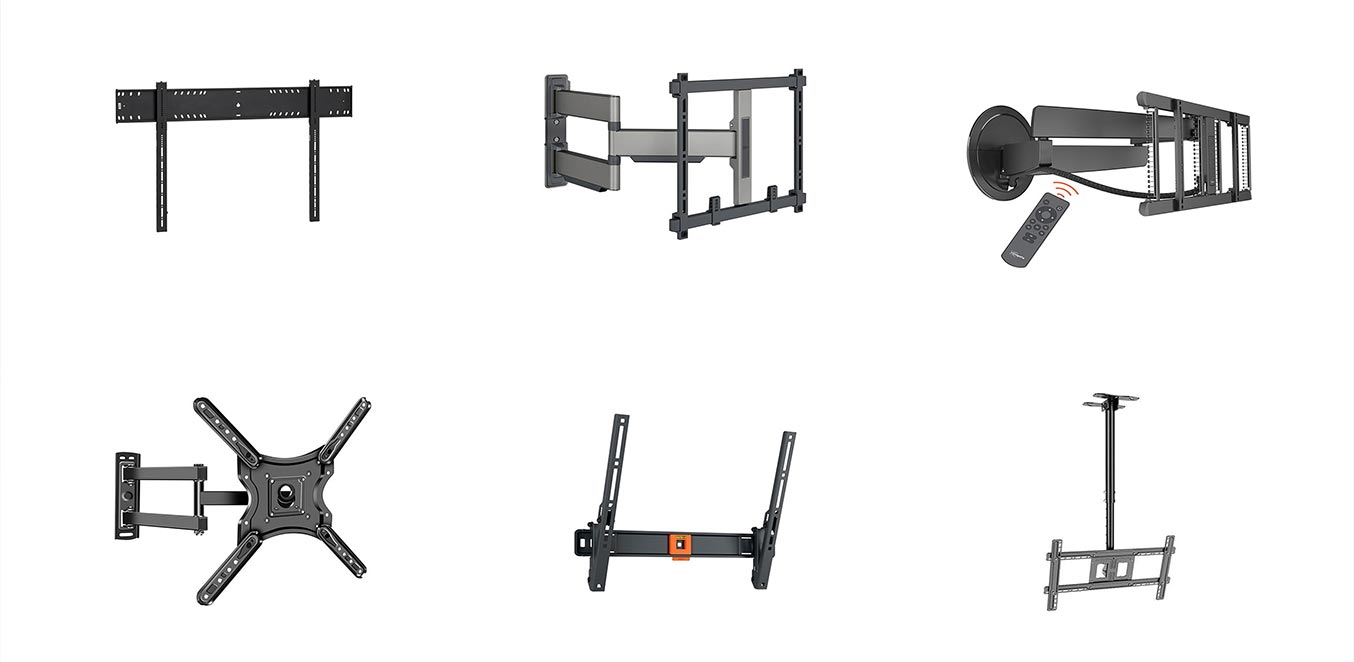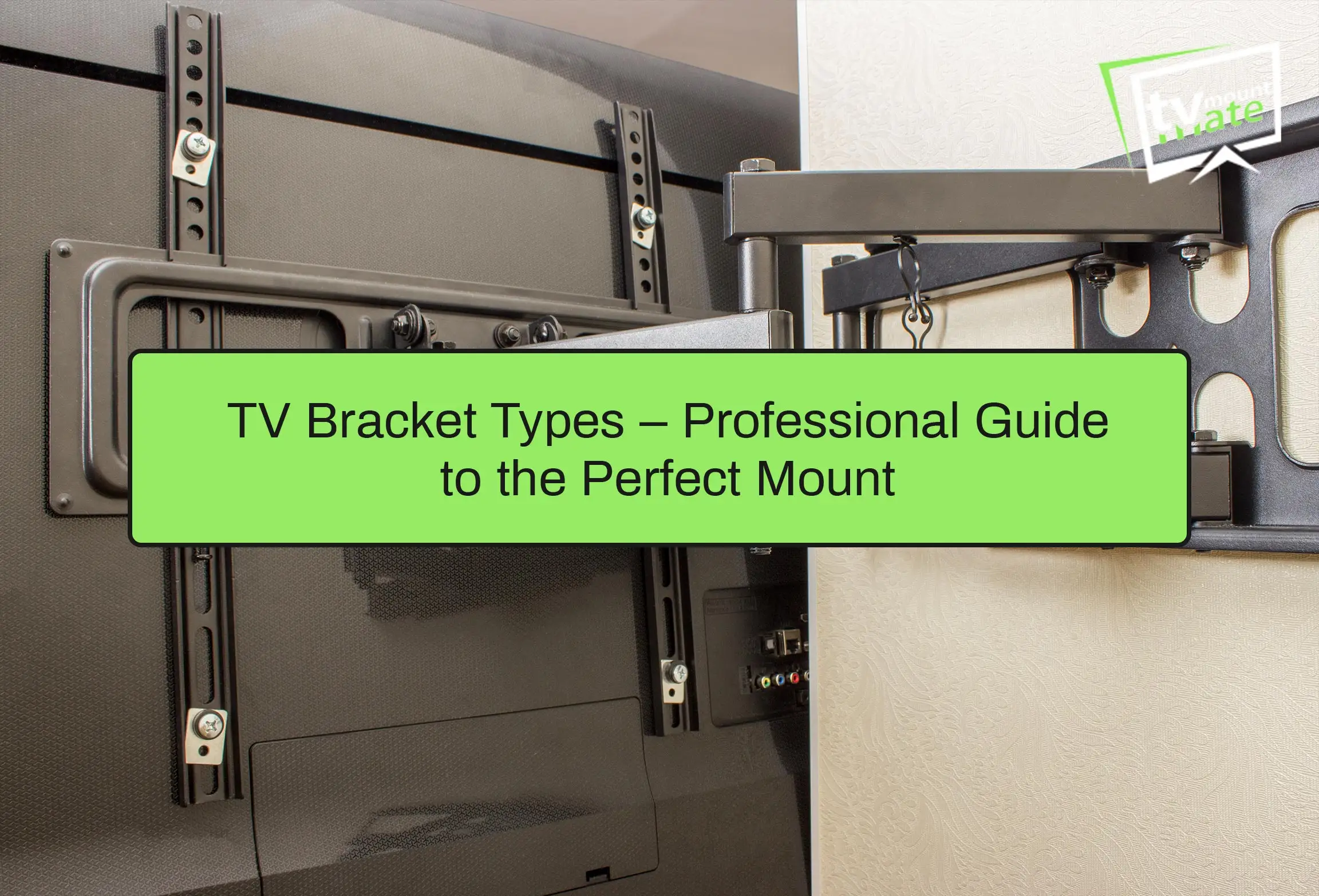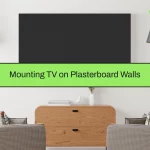TV Bracket Types – Professional Guide to the Perfect Mount.
When discussing TV bracket types, many people look for the best tv bracket for plasterboard wall to ensure safety and durability. Choosing the right TV wall bracket can transform your living space, improving both safety and your viewing experience. The wrong choice could mean poor angles, instability, or even damage to the wall. Over more than a decade of installations in London, I’ve worked with a wide range of mounting solutions — from budget-friendly fixed mounts to premium motorised systems — for every screen size and wall type imaginable.
Here’s my guide to the most common mounting bracket styles, when to use them, and real-world stories from jobs I’ve completed.

Low Profile TV Brackets – Sleek and Space-Saving.
If you want your flat screen to sit almost flush to the wall, a low profile TV bracket is the best choice. Often called a slim TV wall mount or slim wall mount TV bracket, this design is popular for modern homes because it creates a clean, built-in look. I once fitted a slimline TV bracket in a caravan where every centimetre mattered. The result was the slimmest TV wall mount I could find that still supported the weight safely.
These work well for smaller VESA sizes and lighter TVs. For larger models like a 60 inch, I always reinforce the fixings, especially on plasterboard. Some of the most common TV bracket types include options designed as a tv bracket for plasterboard, which spread weight evenly. Slimline designs remain popular among TV bracket types, especially when paired with a flat screen TV and wall mount.
Tiltable TV Brackets – Better Angles, Less Glare.
A tiltable TV bracket is perfect if you need to angle your TV up or down, reducing glare and making high installations more comfortable. Above fireplaces, I often use a tilt TV wall bracket or a tiltable TV wall mount to help clients enjoy their shows without neck strain.
One memorable job in Royal Wharf involved a client who insisted on mounting the TV in a specific spot, even if it meant awkward viewing angles. A tilt TV wall mount solved the problem perfectly, keeping her posture comfortable and the image clear.
Long Arm TV Brackets – Maximum Flexibility.
For households that watch TV from different parts of the room, a long reach TV bracket offers unmatched flexibility. I’ve installed both extra long TV bracket models and more compact long arm TV wall mount versions, depending on the space. These allow you to pull the TV out, swivel it, and push it back when not in use.
The key with these is to check the max VESA rating before buying, especially for larger inch screens. For TVs over 55 inches on plasterboard, I generally recommend an alternative to avoid stressing the wall.
EXCELLENTTrustindex verifies that the original source of the review is Google. Rony did my TV wall mounting service in Chingford area E4. He provided me same day TV wall mounting service which was really handy and gave me a very competitive price. He is efficient, professional and knowledgeable at his work when it comes to mounting TVs or gone cinema installation. His work is very clean he didn't leave any dust on the floor. Highly recommend.Trustindex verifies that the original source of the review is Google. Rony did my 77 inch Samsung tv wall mounting service in Enfield area. He was on time and did an excellent job mounting my tv. He cleaned the area after his job. Excellent service. Highly recommended.Trustindex verifies that the original source of the review is Google. Rony did my TV wall mounting in SE17 and it was a perfect job providing same day TV installation. Wall mounting my Sony 55 inch tv, Very professional, clean and friendly service. I called a few other companies and he was the one who provided me the best competitive price to wall mount tv.Trustindex verifies that the original source of the review is Google. Very friendly and efficient! Would definitely recommend to othersTrustindex verifies that the original source of the review is Google. Rony was fantastic. Knows exactly what he’s talking about and delivers. Cannot recommend him enough. Our 65 in tv wasn’t easy to put up and he still did it. Thank you! Having the tv on the wall as we move into our new flat has made it begin to feel like home.Trustindex verifies that the original source of the review is Google. We had such a great experience with Tv Mount Mate! They mounted our TV perfectly—everything is secure, level, and looks amazing. On top of being professional and efficient, they were also so kind and friendly, which made the whole process even better. We really appreciated their helpfulness and would 100% recommend them to anyone needing a TV installation.Trustindex verifies that the original source of the review is Google. Rony did a fabulous job, showed up on time, he had all the materials required (even for my TV which is old and required a non-standard mounting) and was friendly, helpful, he answered all our questions and gave advice to make the area look better. Fully recommend!!Trustindex verifies that the original source of the review is Google. Rony did mount tv in my north London house. He has done an excellent job mounting my 55 inch tv. He is very professional, clean job and arrived in 20 minutes. Highly recommended if anyone needs television wall mounting service.Trustindex verifies that the original source of the review is Google. Rony was brilliant, he really went above and beyond. He came within 2 hours of us calling him and not only installed the mount without leaving so much as a speck of dust, but levelled our TV cabinet and concealed the wiring free of charge. He was friendly and knowledgeable about his domain, too, explaining (for example) what height the TV should be at and why. Really excellent service and I can’t recommend him enough.Trustindex verifies that the original source of the review is Google. Ronny did a great job mounting my TV. He was punctual, professional and friendly. Very happy with the job and would recommend to anyone in the Putney area.Verified by TrustindexTrustindex verified badge is the Universal Symbol of Trust. Only the greatest companies can get the verified badge who has a review score above 4.5, based on customer reviews over the past 12 months. Read more
London’s 5-Star TV Wall Mounting Reviews—See What Customers Say.
Rotating TV Wall Mounts – Perfect for Corners.
When you need to turn your wall mounted TV towards different parts of a room, a 360 rotating TV bracket is ideal. I’ve installed rotating bracket designs in tight spaces and even a spinning TV wall mount for a client who wanted to watch from both their kitchen and living room.
For a project in Canada Water, a rotating TV wall mount with a TV arm mount swing arm mechanism made it possible for one TV to serve two seating areas. Just be cautious with cheaper versions — heavier LCD LED screens can cause them to sag over time.
Motorised TV Brackets – Remote-Control Convenience.
For those who want the ultimate luxury, a motorised mounting bracket allows you to adjust your TV’s position with the touch of a button. I once installed one above a fireplace, taking into account heat, wiring, and perfect alignment. The client could mount your television high on the wall and still bring it down to the ideal angle for watching.
Ceiling TV Mounts – Smart for Tight Spaces.
In shops, gyms, or small apartments, a ceiling mount is sometimes the most practical solution. Just like with any installation, safety comes first — I always ensure these are secured into ceiling beams rather than plasterboard.
Common Bracket Buying Mistakes.
- Ignoring the TV’s VESA sizes and weight limits.
- Choosing the cheapest option rather than a high quality bracket.
- Trusting retail recommendations without knowing your wall type.
Check our article on – TV Brackets for Plasterboard Walls: Safe & Secure Fit
Brands I Recommend.
- Vogel and Sanus – premium, long-lasting builds.
- Invation and One For All – solid mid-range choices.
- Sandstrom – good quality for everyday setups.
- Avoid unbranded eBay specials if you want to mount your TV safely.
Key Takeaways.
- Always match your bracket to your wall type and screen size.
- A fixed bracket like a slim TV bracket works for sleek looks; a tilt TV bracket or long arm TV bracket adds flexibility.
- Check max VESA ratings before purchase.
- Plan ahead for cable management before you mount your TV.
Conclusion.
The right bracket not only supports your TV but also enhances your viewing experience. Whether you’re replacing a TV stand or upgrading to a wall mounted TV, choosing the right style — from a slimline TV bracket to a rotating TV wall mount — will keep your setup safe and stylish.
Every installation I do includes a workmanship warranty, and if you need adjustments within 30 days, I’ll return free of charge. I’m not regulated by the Financial Conduct Authority, but I am regulated by years of hands-on experience and a reputation for getting it right.
If you want your installation done properly the first time, contact me today for expert advice and to mount your television securely.






Leave a comment